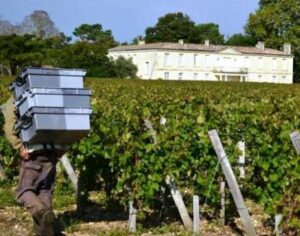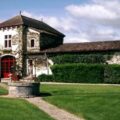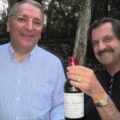
Jeff Leve Will 2013 Smith Haut Lafitte be known for its low yields?
Fabien Teitgen “The yields are very low for us in Pessac Leognan. We have around 10 percent less in white Bordeaux wine. The yields are going to be close to 27 hectoliters per hectare and 28 hectoliters per hectare. For the red Smith Haut Lafitte, I ‘m afraid that we could have 20 percent less wine than usual.”
Jeff Leve Even though it is early, do you have an idea as to what percentage of the crop you will place in the Grand Vin?
Fabien Teitgen “It’s difficult to answer now. I think that we need to select strictly to keep a good level of quality. Perhaps we will have less than 45 % of first wine.”
Jeff Leve How late was the 2013 vintage for you at Smith Haut Lafitte?
Fabien Teitgen “Interestingly, 2013 Smith Haut Lafitte was our latest vintage for the beginning of the crop, but not for the end of the harvest.”
Jeff Leve Going over the growing season, what took place for you during the flowering?
Fabien Teitgen “The flowering was variable depending on the weather conditions. The earlier Merlot completed flowering during the week of Vinexpo under very strong rains and cold temperatures. For the other Merlot and Cabernet, the flowering took place the following week under much better conditions with no rain and medium temperatures. The consequences were a strong “coulure” for the young Merlot and a soft “coulure” for the other parcels.”
Jeff Leve What about for your white wine grapes?
Fabien Teitgen “For the white wine grapes, the flowering occurred the week before Vinexpo, so we had no problems.”
Jeff Leve Did the coulure affect primarily the Merlot, or with the entire vineyard?
Fabien Teitgen “We had problem of coulure with some Merlot that ended up giving us yields of less than 10 hectoliters per hectare. For the other Merlot parcels, we had no problems. For the Cabernet Sauvignon, I think we had a soft coulure. Soft coulure is positive because the grapes were not compact. Plus a small number of grapes by foot is better for ripeness. It’s easier to find a good level of maturity with small yields especially when the weather is difficult.”
Jeff Leve Speaking of difficult weather, was 2013 Bordeaux one of the wettest vintages for you at Smith Haut Lafitte?
Fabien Teitgen “No, not really. We had the same quantities of rain in 2001 and we had 10 % more rain than in 2003!!! So this vintage was wet. 2013 Smith Haut Lafitte is one of the wettest years, but it was not a deluge.”
Jeff Leve Still, 2013 Bordeaux is a wet vintage. With all that water in your vines, did you have problems when temperatures heated up in July?
Fabien Teitgen “The rain stopped June 23 and the temperature begun warm, moving up to between 20 – 25 ° centigrade. So the vines had time to dry and get used to the warmer temperatures slowly before they experienced the 20 days of more than 30 ° centigrade in July. We had water deep in the soil so the vines were able to find water for sweating. So we really did not have problems in the vines in July.”
Jeff Leve What happened next?
Fabien Teitgen “At the end of June we were two weeks late. We needed good weather, good energy and hot temperature for help to obtain ripeness in the grapes and we needed more time. So after the good summer, with the beginning of the Indian summer we were happy and very optimistic.”
Jeff Leve Did your organic or biodynamic farming help with the 2013 Bordeaux vintage?
Fabien Teitgen “Depending of the technique the results were really different. For example, with organic growing, we had good results. But with biodynamic farming techniques the result were not as good due to the very fast growth of botrytis.”
Jeff Leve What anti rot techniques did you perform to deal with the potential for botrytis?
Fabien Teitgen “With 2013 Smith Haut Lafitte, we needed to aerate the grapes area, so a good “effeuillage” was a positive beginning to fight against botrytis. The strength of the vines was a strong factor to fight botrytis. At Smith Haut Lafitte, with poor soils, good drainage and grass in the vines, the vines are very well balanced and have a better resistance against fungus. All the things we done in the vineyard helps us to find a good balance between the vines, soil and plants. Our biosphere helps the vines to resist against fungus.”
Jeff Leve When did you begin harvesting?
Fabien Teitgen “We began the harvest for the white wine grapes September 18. We waited until October 1 to start picking the fruit for the red wine.”
Jeff Leve When did you complete the 2013 Smith Haut Lafitte harvest?
Fabien Teitgen “We finished with the white wine grapes September 30. It took two more weeks to the rest of the Cabernet Sauvignon, Cabernet Franc and Petit Verdot.”
Jeff Leve Due to the changing weather conditions, did your team pick at a faster pace than usual?
Fabien Teitgen “Yes for the red grape harvest we decided to pick quicker than usual because of the wet weather conditions. At that point we had more to lose than gain.”
Jeff Leve How much faster?
Fabien Teitgen “With 2013, we picked in two weeks. Usually we take three weeks to finish the harvest.”
Jeff Leve Was optical sorting handy this year?
Fabien Teitgen “Yes we used optical sorting machines this year. We were very happy to know very well this machine. Optical sorting helped us remove all the small green or pink berries.”
Jeff Leve Would you say 2013 required more sorting than usual?
Fabien Teitgen “We needed to sort more than usual because of rot. It’s important to keep in mind that most of the sorting was done in the vineyard during the harvest. The pickers removed the unripe grapes and those suffering from botrytis. In the cellar, with all the machines, the sorting was really efficient on some crushed berries, and on the small green and pink berries which amounted to perhaps another 10% of the crop.”
Jeff Leve With the problems the Merlot encountered coupled with its low yields, do you think 2013 will be a Cabernet Sauvignon vintage?
Fabien Teitgen “It could be a Cabernet Sauvignon vintage, if you have hot soil and old vines.”
Jeff Leve Why?
Fabien Teitgen “Because old vines are very stable even if the weather conditions are difficult and those vines were able to find a good level of maturity.”
Jeff Leve What is the 2013 Smith Haut Lafitte Cabernet Sauvignon like this year stylistically?
Fabien Teitgen “The Cabernet Sauvignon are very well balanced with good freshness. Medium to full body, very long with good texture plus nice aromatics and complexity.”
Jeff Leve Did you chaptalize this year?
Fabien Teitgen “No.”
Jeff Leve What are your alcohol and pH levels?
Fabien Teitgen “With the white wine grapes we are between 12.3% to 13.8% alcohol with a pH between 3.07 and 3.24. The total Acidity is between 5 and 6 g/H2SO4. For the red wines, we range from 12.4% to 13.7% alcohol. The pH is close to 3.4 and 3.6.”
Jeff Leve What will you do this year during the vinification and elevage?
Fabien teitgen “We tried to extract only the positive elements in the berries, quietly. Now, after ecoulage, we’ll conduct a soft and very protective aging with all the lees. Lees can help the wine in reductive aging with less oxygen (no racking). We want to keep the whole matter of our wines.”
Jeff Leve Did you purchase any new equipment this year?
Fabien Teitgen “We built a new cellar for the vinification and the aging of our second wines and for Chateau Le Thil. We also did a total renovation of the cellar of Smith Haut Lafitte with new small wooden vats, with new vertical presses with gravity transportation of the berries. All of this new equipment will help continue increasing the quality of the wine at Smith Haut Lafitte.”




3 Comments
2013 Smith Haut Lafitte Harvest Vintage Report Interview | The Wine Cellar – Jeff Leve | vía @JeffLeve | http://t.co/Eb3SjS3tNg
.@ChateauSHL Interview with Fabien Teitgen on everything that took place with 2013 vintage/harvest Smith Haut Lafitte http://t.co/oj8DkCJR6j
2013 Smith Haut Lafitte Harvest Vintage Report Interview http://t.co/QcTDIGmIsL